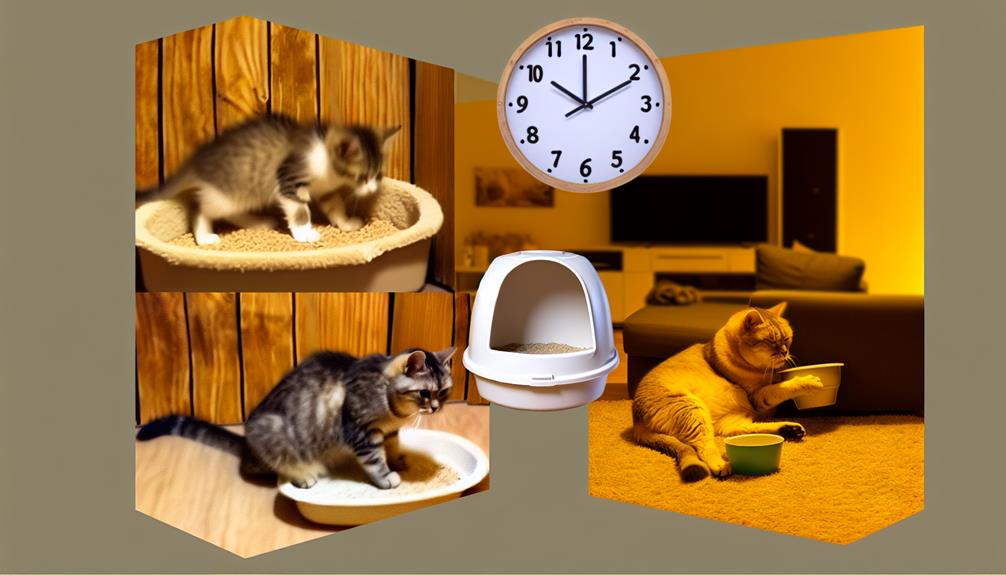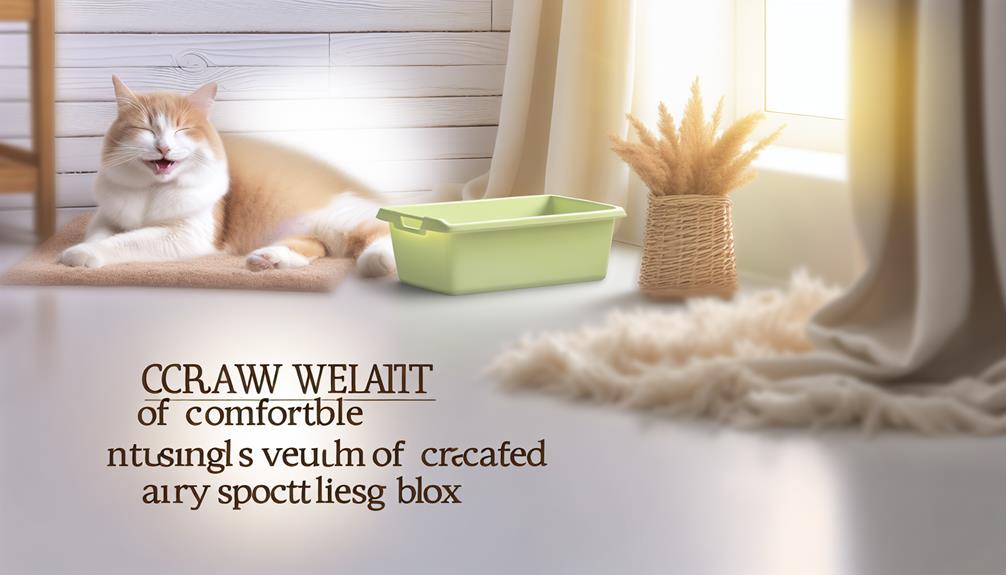You might think that monitoring how often your cat pees isn't that important, but it actually offers valuable insights into their health. Typically, cats urinate 2 to 4 times a day, but this can vary based on factors like hydration, diet, and overall health. High-protein diets or a lack of fresh water can affect how frequently they pee, while conditions like urinary tract infections may alter their patterns. Keeping an eye on these habits can help you catch potential health issues early. Curious about what else might influence your cat's bathroom behavior? There's more to reflect upon.
Typical Urination Frequency
When it comes to understanding your cat's urinary habits, knowing the typical urination frequency is essential. Cats generally urinate between two to four times per day. This frequency can be influenced by a variety of factors, but in a healthy feline, these numbers offer a reliable baseline.
Urination frequency in cats is closely tied to their hydration status and overall health. You might observe that your cat visits the litter box in a regular pattern, which can give you insights into their behavior and well-being. Cats are creatures of habit, and any considerable deviation from their typical urination routine warrants attention. For instance, if your cat is urinating more frequently or less often than usual, it could indicate underlying medical conditions that require veterinary evaluation.
In clinical practice, veterinarians assess a cat's urinary habits as part of their routine health check-ups. By monitoring the frequency and volume of urination, they can identify early signs of issues such as urinary tract infections (UTIs), kidney disease, or diabetes mellitus. These conditions can considerably alter a cat's urination patterns and, if left untreated, may lead to severe complications.
Behavioral aspects also play a role in urination frequency. Stress, changes in environment, or even alterations in diet can impact how often your cat needs to urinate. For example, a stressed cat might urinate more frequently due to increased fluid intake or anxiety-related behaviors.
Understanding your cat's typical urination frequency helps you maintain their health and identify potential problems early. Regular monitoring and noting any changes can provide valuable information for your veterinarian, ensuring your cat remains healthy and comfortable.
Influencing Factors
To understand a cat's urination frequency, you must consider factors like diet and hydration, as well as health and medication. A diet high in moisture content will naturally increase urine output, while certain medical conditions and medications can either elevate or reduce urination. Monitoring these variables is essential for maintaining your cat's urinary health.
Diet and Hydration
A vital aspect influencing the frequency of a cat's urination is its diet and hydration status. Cats derive hydration from various sources, mainly water and the moisture content in their food. If your cat consumes wet food, which typically contains about 70-80% water, it will naturally have better hydration levels compared to cats that eat dry kibble, which only contains about 10% moisture. The increased moisture intake from wet food can lead to more frequent urination.
Dietary impacts are also profound. High-protein diets produce more metabolic waste, necessitating increased urination to expel these by-products. Conversely, diets rich in salts and minerals can lead to concentrated urine, potentially causing less frequent but more voluminous urination episodes.
It's essential to guarantee your cat has access to fresh water at all times. Environmental factors like temperature and activity levels also play a role in hydration needs. Cats that drink insufficient water may suffer from dehydration, leading to decreased urination frequency and potential health complications such as urinary tract infections or kidney issues. By monitoring and adjusting your cat's diet and hydration sources, you can promote optimal urinary health and frequency.
Health and Medication
Your cat's health status and any medications it may be taking can greatly influence its urination patterns. Conditions affecting the urinary tract, such as urinary tract infections (UTIs) or urinary stones, can lead to increased frequency or discomfort during urination. A UTI, for instance, might cause your cat to urinate more often but in smaller amounts, and you might notice signs of distress.
Kidney health plays a significant role as well. Chronic kidney disease (CKD) is common in older cats and can cause polyuria (excessive urination) due to the kidneys' diminished ability to concentrate urine. This condition often necessitates increased water intake and frequent trips to the litter box.
Medications can also impact urination. Diuretics, commonly prescribed for heart conditions, increase urine production. Conversely, certain pain medications or anti-inflammatory drugs might reduce urination frequency by affecting kidney function or altering fluid balance.
Monitoring your cat's urination habits can provide valuable insights into its overall health. If you notice significant changes, consulting a veterinarian is essential. They might suggest diagnostic tests, such as urinalysis or blood work, to assess urinary tract health and kidney function, ensuring timely and appropriate medical intervention.
Age and Peeing Patterns

Understanding how a cat's age influences its urination patterns is essential for early detection of potential health issues. Throughout a cat's life stages, from kitten development to senior habits, urinary frequency and volume can exhibit significant variations.
Kittens, due to their smaller bladders and high metabolism, tend to urinate more frequently. This is part of their growth phase where hydration and nutrient processing are accelerated. Typically, kittens may urinate as often as every few hours. As they mature into adult cats, their urination frequency stabilizes, usually ranging from 2 to 4 times per day. This can vary based on individual health status and environmental factors.
Senior cats, on the other hand, often exhibit changes in urination patterns due to age-related health issues such as chronic kidney disease or diabetes. These conditions can lead to increased urination frequency (polyuria) or, in some cases, decreased frequency due to urinary retention issues. Monitoring these patterns is vital as deviations from the norm can be indicative of underlying medical concerns that require veterinary attention.
Here is a summary table to illustrate the typical urination patterns across different age groups:
| Age Group | Typical Frequency | Notable Characteristics |
|---|---|---|
| Kittens | Every few hours | High metabolism, small bladder size |
| Adult Cats | 2-4 times per day | Stabilized patterns, individual variance |
| Senior Cats | Varies widely | Potential polyuria or urinary retention |
Diet and Hydration
Diet and hydration greatly influence a cat's urination frequency. Increased water intake generally results in more frequent urination, while the type of food—wet or dry—affects hydration levels. As you evaluate your cat's peeing patterns, consider these variables to guarantee the best urinary health.
Water Intake Impact
When considering how often cats urinate, it is crucial to examine their water intake, which is directly influenced by their diet and overall hydration. Water intake plays a pivotal role in maintaining a cat's hydration balance and subsequently affects urinary frequency. Cats typically get their water from both drinking and their food, making water absorption a key factor.
A well-hydrated cat will generally urinate more frequently, as their kidneys are better able to filter waste and maintain electrolyte balance. Conversely, insufficient water intake can lead to concentrated urine, reduced urinary frequency, and potential health issues like urinary tract infections or kidney stones.
Clinical studies indicate that cats on a wet food diet tend to have a higher water intake compared to those on dry food, thereby affecting their hydration status and urination patterns. Monitoring your cat's water consumption and ensuring they have constant access to fresh water can help maintain ideal hydration balance. This not only supports regular urination but also promotes overall renal health.
Food Type Effects
Different types of cat food greatly impact both diet and hydration, ultimately influencing urinary frequency. When you opt for wet food, your cat benefits from increased hydration sources, reducing the risk of urinary tract issues. Conversely, dry food often leads to reduced water intake, necessitating vigilant monitoring of your cat's hydration status.
Key Factors Affecting Urinary Frequency:
- Protein Content and Salt Levels: High protein content and salt levels in food can lead to increased urine concentration, potentially causing dehydration and urinary crystal formation.
- Fiber Intake and Digestive Health: Adequate fiber intake supports digestive health, guaranteeing regular bowel movements, which can indirectly affect urinary frequency.
- Food Additives and Nutrient Balance: Unbalanced food additives can disrupt your cat's overall nutrient balance, leading to metabolic issues that may alter urination patterns.
Meal frequency also plays an essential role. Feeding smaller, more frequent meals helps maintain a consistent nutrient balance and digestive health, promoting stable urinary habits. By carefully selecting high-quality cat food and monitoring these factors, you can confirm your cat's urinary system remains healthy and functional, ultimately reducing the risk of complications.
Recognizing Abnormal Signs

Observing your cat's urinary habits is essential for early detection of potential health issues. Abnormal signs in urinary health can indicate underlying medical conditions that require prompt attention. Let's explore what you should look for.
Firstly, monitor any significant behavioral changes. Cats are creatures of habit, and deviations from their usual routine can be a red flag. If your cat starts frequenting the litter box more often than usual, or conversely, if there's a marked decrease in urination, these could be signs of urinary tract infections (UTIs) or other urinary health issues.
Pay close attention to the volume and frequency of urination. Cats typically urinate two to four times daily. A noticeable increase or decrease can signify problems such as kidney disease, diabetes, or bladder stones. Additionally, straining to urinate or producing only small amounts of urine are concerning indicators. Straining could be a symptom of feline lower urinary tract disease (FLUTD), which is a broad term encompassing several urinary conditions.
Another critical aspect is the appearance of the urine. Blood in the urine, known as hematuria, is a serious sign that shouldn't be ignored. This could point to infections, bladder stones, or even tumors. The presence of an unusual odor or color can also be indicative of underlying health issues.
Behavioral changes like vocalizing while urinating, avoiding the litter box, or excessive grooming of the genital area are also significant. These behaviors often accompany discomfort or pain, signaling that something is amiss with your cat's urinary health.
When to Consult a Vet
A cat's urinary health is vital, and timely veterinary intervention is necessary when abnormalities arise. If you've noticed any deviations from your cat's typical urination patterns, it's important to consult a vet promptly. Cats are adept at masking discomfort, so subtle signs might be the only indicators of a serious underlying issue, such as a urinary tract infection (UTI) or feline lower urinary tract disease (FLUTD).
Here are three key situations that necessitate immediate veterinary attention:
- Frequent Urination Outside the Litter Box: If your cat starts to urinate in unusual places, it could be a sign of urinary discomfort or blockage. Behavioral changes like these often indicate that something is amiss with their urinary health.
- Straining to Urinate: This can be indicative of a blockage, which is a veterinary emergency. Straining without producing much urine, vocalizing while attempting to urinate, or showing signs of distress should prompt you to seek veterinary care without delay.
- Blood in Urine: Hematuria (blood in the urine) is a clear sign that something is wrong. This condition can be associated with infections, bladder stones, or even cancer. Immediate evaluation by a veterinarian is essential to determine the cause and initiate appropriate treatment.
Ignoring these symptoms can lead to severe complications, including kidney damage or life-threatening blockages. Additionally, early intervention improves the prognosis and can often mitigate extensive treatment costs in the long run. Your cat relies on you to notice these behavioral changes and to act swiftly. Consulting a veterinarian not only secures your cat's urinary health but also supports their overall well-being and longevity.
Conclusion
So, how often should you really be monitoring your cat's urination patterns? Given their typical frequency of 2 to 4 times daily, any significant deviations could signal underlying health issues. Factors like age, diet, and hydration greatly impact these patterns. Are you noticing changes or abnormalities? It's vital to recognize these signs early and consult a vet when necessary. Your vigilance is essential in maintaining your cat's health and ensuring any medical conditions are promptly addressed.
